Bones

Searching for Bones
Saturday, July 13, 2013

Having built a half dozen mics based on the MXL 990, it’s time for something new. This time around, I know I’m using a Microphone-Parts RK-47 capsule, and probably building the electronics from scratch. So I want a chassis with a bit more room which doesn’t take a round circuit board, and I don’t care what capsule comes inside.
A search of the bay of E turned up a few possibilities, and the one which I settled on was an importer of all sorts of Chinese merchandise from fake fingernails and handbags to “professional network capacitor microphones.” The seller had two basic models, a U-87 style ice cream cone with wedge headbasket, and a lollipop style. The description was in Chinglish and more than a little vague, but the size was right, and most importantly the price was right, about $45 for mic, spider shock mount, and windscreen. Available in various colors and prices. Black and red cost twice as much as silver, pink, or white paint. Hi yo, silver it is !
A few days later, the postman delivered the package, and here it is. Everything is in Mandarin, but it turns out the mics will record English speakers as well.
When building microphones I look for cheap mics with good bones to build upon. In the past, I started with MXL’s 990 and 991, cheap mics with good bones and pretty good guts. This time around I want something a bit different, and I know I’m not using the guts, so all I want is a solid but cheap chassis.

The mic itself doesn’t look bad. Silver body with chrome headbasket and end caps. Feels solid and heavy, no plastic, not flimsy. The shock mount is strong enough and grips tightly. The foam windscreen is foamy and fits nicely. What’s not to like? It makes audio when plugged into my Audio Buddy.
So far, so good. I think we have a winner.
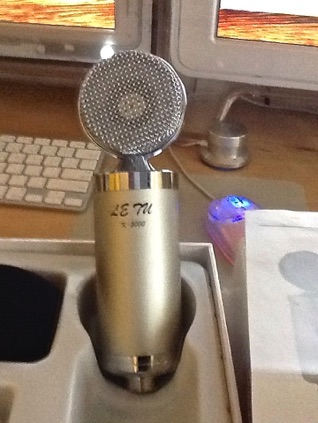
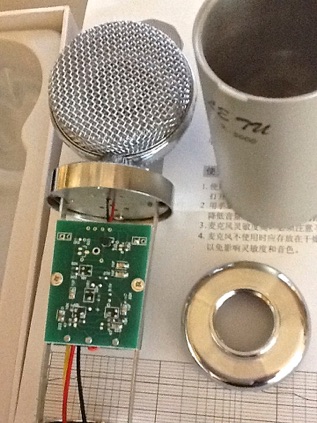
Spinning off the base cap, we find the familiar construction of most Chinese mics. In fact the lower shell of an MXL 990 screws right on to the Universal Chinese Mic dual-diameter XLR holder and mic base. Two circuit boards, one appears to be a variation on the Schoeps / UCM circuit, and the other appears to be superfluous. Small diameter capsule, about 18 or 20 mm outside diameter.
So in the name of science and curiosity, let’s have a deeper look before disemboweling the shiny new lollipops. Stuck ‘em in front of the standard office speakers and recorded the test sequence. Not half bad, actually. (Hear here.) A bit bass shy, but they are sold for Karaoke, so proximity effect will correct that. Somewhat hot on top, with a presence rise of 4 dB in the 3 - 5 KHz area, a 2dB absence dip around 8 KHz, and a rising top end from 9 KHz to about 8 dB hot at 13 KHz before falling off fairly gradually to 16 KHz, and more rapidly above that. In all, a mic with good articulation and clarity. Slightly spitty. Sounds good on the tenor and female voice.
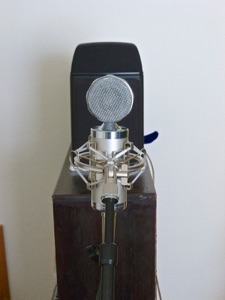

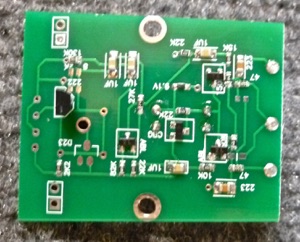

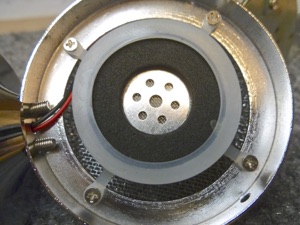
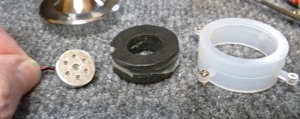
OK, so much for science. Done our due diligence. Let’s rip this sucker apart.
Electret capsule. Cardioid. Internal suspension for a 32-34 mm capsule with a foam donut taking up the slack. Cool. The RK-47 will drop right in.
So what’s the circuit like? Five transistors instead of the usual three? A bit of sleuthing, and...
Pardon the sloppy drawing. Too lazy to enter it all into the CAD program.
The capsule is an electret without built-in FET. The first stage is a basic FET amplifier with voltage gain. No fixed bias. The K596 FET has an internal bias diode, so the first part is equivalent to a Panasonic capsule.
The second stage is the phase splitter. A transistor with equal load resistors on the emitter and collector. This stage generates equal and opposite balanced outputs. The 2.7K resistor and pair of 1uF caps form a low-cut filter. Schoeps used the FET as both amplifier and phase splitter.
The last stage is the familiar emitter follower line driver which provides no voltage gain, has current gain only, and lowers the output impedance for driving long cables. As a byproduct, it provides power for the rest of the mic.
The transistor and zener at top are hooked up as a voltage regulator to provide about 8.8 V power to the first two stages.
An interesting mic. Decent for the price, and the chassis is fine. Next time, building on that chassis.
This board is unused.
It is not connected in any way to the circuit.


